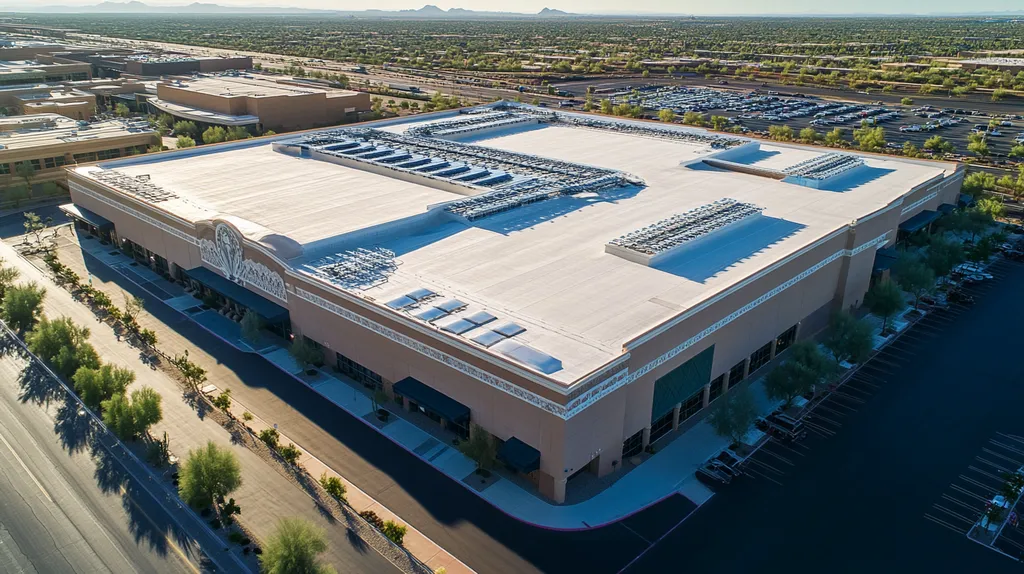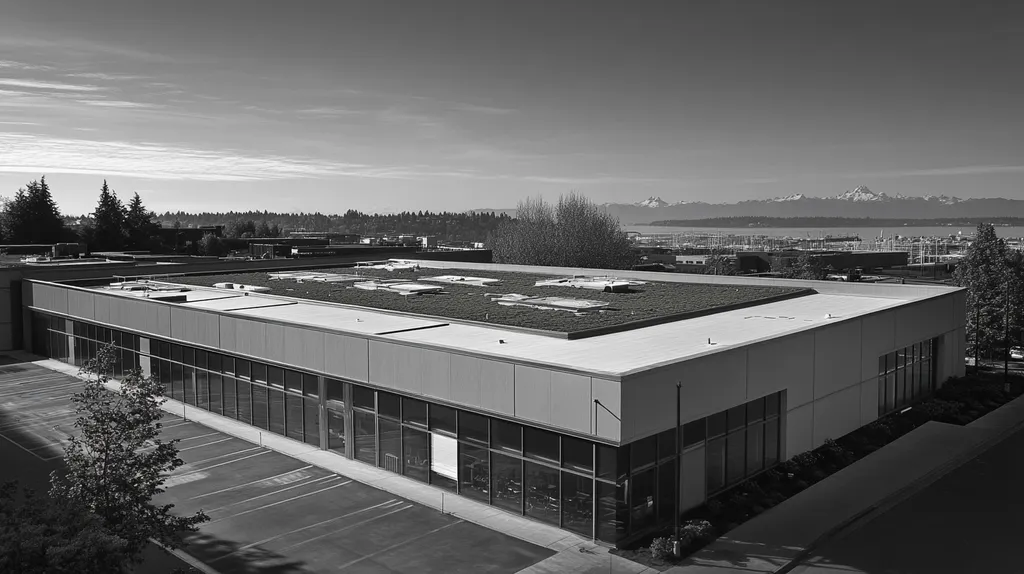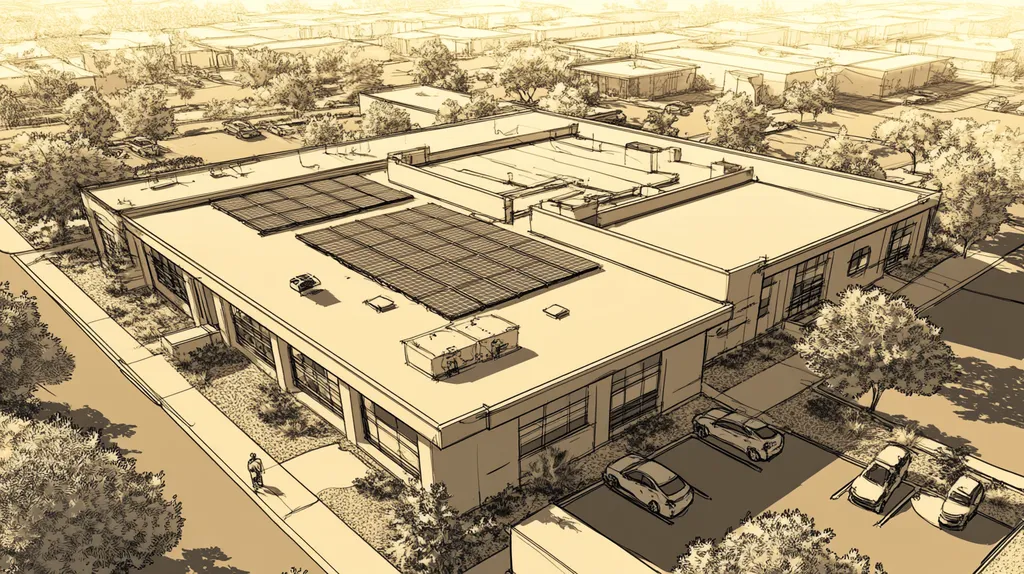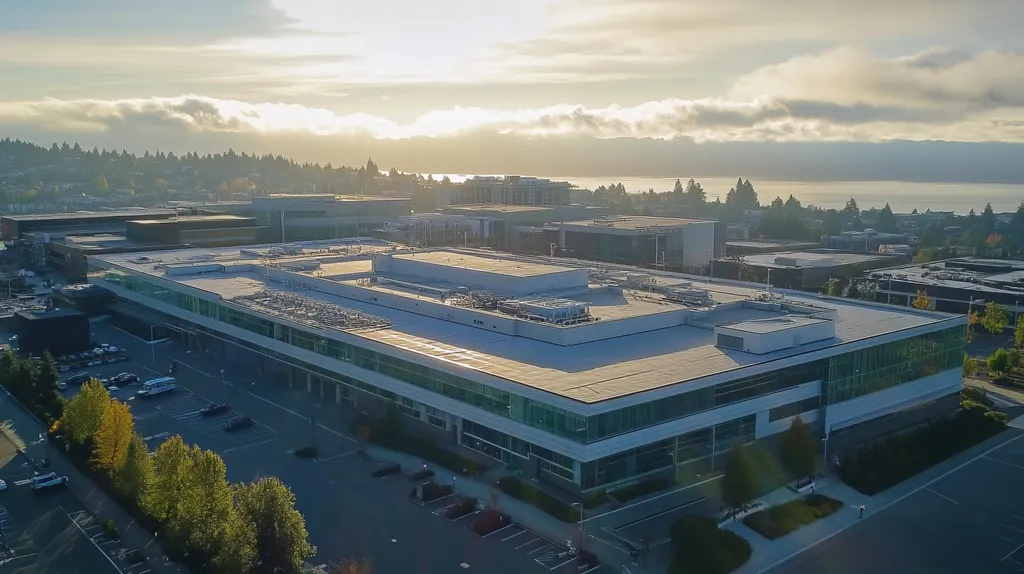With energy costs rising 25% in the past decade and climate change accelerating, commercial property owners face mounting pressure to adopt sustainable roofing solutions. Traditional roofing materials contribute significantly to urban heat islands and energy waste, costing businesses millions in preventable expenses.
Modern eco-friendly roofing options offer compelling alternatives, from solar-reflective membranes to green roof systems that can reduce cooling costs by up to 30%.
This comprehensive guide examines the critical factors property professionals must consider when evaluating sustainable roofing solutions, from performance metrics and financial implications to compliance requirements and risk management strategies.
SECTION 1: PERFORMANCE FACTORS
With climate change and energy costs continually on the rise, property professionals face an urgent need to explore eco-friendly roofing alternatives. Commercial buildings are pivotal contributors to energy consumption, making the transition to sustainable materials not just advantageous but vital for ensuring long-term savings and environmental care. Understanding key performance factors when selecting roofing solutions is essential; doing so can enhance energy efficiency, improve durability, and alleviate urban heat islands.
Energy Efficiency and Reflectivity Ratings
Energy efficiency is a vital aspect of eco-friendly roofing. Many modern roofing materials feature reflectivity ratings, which reveal how effectively they can bounce back sunlight. Roofs with high Solar Reflectance Index (SRI) can dramatically lower cooling expenses. For example, a white reflective membrane may reduce heat absorption and air conditioning needs by up to 15% in warmer areas.
On top of that, energy-efficient roofing helps cut greenhouse gas emissions. By opting for materials with high reflectivity, buildings can also assist in mitigating urban heat islands, a phenomenon that raises city temperatures. Property professionals should aim for roofing systems that comply with or surpass Energy Star standards to align performance and sustainability.
When evaluating energy efficiency, it’s essential to weigh long-term savings on utility bills against initial expenses. Some eco-friendly materials might have a higher upfront investment, but they generally outperform conventional options over time, yielding significant energy savings.
Key Action Items
Durability and Weather Resistance of Eco Materials
Durability is crucial when choosing roofing materials, particularly in regions exposed to extreme weather. Eco-friendly roofing materials frequently employ advanced technologies to endure diverse climates. Take thermoplastic olefin (TPO), for instance—it’s a popular choice due to its ability to resist UV deterioration and punctures.
Moreover, many eco-friendly options come with robust manufacturer warranties, providing property owners with the peace of mind about longevity and durability. Materials designed to be hydrophobic can help reduce water damage, which is especially useful in rainy regions.
In the end, a roof’s durability affects not just its lifespan but the overall efficiency of the building. A more durable roof means fewer replacements and repairs, leading to lower overall costs and less waste.
Key Action Items
Thermal Insulation and Heat Island Mitigation
Effective thermal insulation is crucial for the performance of eco-friendly roofs. Insulation helps lower energy consumption by keeping indoor temperatures stable. Options like green roofs or insulated roof panels can make a significant difference in a building’s energy retention.
By enhancing thermal insulation, property professionals can reduce HVAC demands, resulting in lower costs and a smaller carbon footprint. Additionally, these roofing solutions aid in fighting urban heat islands. For example, green roofs cool their surroundings through a natural process of plant evapotranspiration.
Moreover, the choice of insulation can determine a building’s energy efficiency throughout the year. While selecting materials, it’s critical to consider their thermal resistance (R-value) for optimal efficiency in both summer and winter.
Key Action Items
SECTION 2: FINANCIAL CONSIDERATIONS
The financial impact of choosing eco-friendly roofing options is crucial for commercial property owners and facilities managers. While the initial costs may seem intimidating, understanding the significant long-term savings and benefits can change that perspective. For instance, roofs certified by Energy Star can yield energy savings of 20-30% annually, effectively offsetting those upfront installation expenses. This section will explore costs, available tax benefits, and the overall financial viability of green roofing solutions.
Initial Costs vs. Long-Term Savings Analysis
When assessing eco-friendly roofing options, the initial investment often raises red flags. Traditional roofing systems may appear more budget-friendly at first glance, but they generally lack the energy efficiency benefits of sustainable alternatives. For example, while green roofs may come with a higher price tag upfront, they can significantly reduce HVAC operation costs, making them a savvy financial choice in the long run.
Moreover, energy-efficient roofs, like cool roofs, can lower cooling expenses by reflecting sunlight. Data indicates that businesses adopting these technologies can save thousands on energy bills annually. The key for property owners is to weigh immediate costs against substantial future savings.
Additionally, eco-friendly roofs typically bring long-term financial benefits through reduced maintenance needs and a longer lifespan. Many of these roofs come with extended warranties, adding peace of mind for property owners. In essence, an upfront investment in green roofing options can translate into a strategic, long-term financial asset.
Key Action Items
Eligibility for Tax Credits and Incentives
Property owners should explore the financial benefits of tax credits and incentives associated with eco-friendly roofing materials. Governments and local municipalities often champion green initiatives by providing various financial advantages. For example, federal tax credits for energy-efficient upgrades can significantly lower the costs of installing eco-friendly roofs.
Additionally, certain states may offer rebates for the use of approved energy-efficient roofing systems, and some locales even provide property tax reductions for installations that promote lower energy consumption. This can lead to considerable returns on investments, effectively mitigating initial expenditures.
Utility companies frequently run programs to encourage upgrades to energy-efficient systems, and switching to sustainable roofing options might qualify property owners for rebates or reduced utility rates. Staying informed about these incentives enhances financial savings and offsets the costs of adopting green roofing solutions.
Key Action Items
Lifecycle Cost Assessment and Return on Investment
Understanding the lifecycle costs of a roof is essential for evaluating its overall financial impact. While traditional roofs might have lower initial costs, they often come with ongoing expenses related to maintenance, repairs, and shorter lifetimes. In contrast, eco-friendly roofs generally offer longer lifespans and require less frequent replacements, delivering a stronger return on investment.
A lifecycle cost assessment includes all expenses tied to roofing—installation, maintenance, and eventual disposal of materials. This comprehensive approach empowers property owners to base decisions on long-term financial outcomes rather than just immediate expenses.
Furthermore, eco-friendly roofs can increase property values. Studies have shown that buildings equipped with sustainable roofing solutions often fetch higher sale prices and sell more quickly due to the growing demand for environmentally conscious properties. Recognizing these factors reinforces the financial advantages of investing in eco-friendly roofing options.
Key Action Items
SECTION 3: COMPLIANCE REQUIREMENTS
As the drive towards sustainability accelerates, adhering to environmental and building codes is crucial for commercial roofing projects. Ignoring these standards can lead to hefty fines, project delays, and adverse environmental effects. Property owners and facility managers must navigate a maze of regulations that oversee eco-friendly roofing options, making understanding compliance requirements essential for balancing sustainability with practicality.
Environmental and Building Code Standards
Environmental standards established by local, state, and federal governments dictate permissible materials and practices for roofing systems. Many areas require roofs to meet specific energy efficiency ratings to combat urban heat islands. Property owners must ensure compliance to avoid potential penalties and ensure their roofs contribute positively to the environment.
Building codes specify safety and performance criteria for roofing materials, which enhances both the durability of roofs and the safety of occupants. By using materials that align with these codes, property owners can also benefit from reduced insurance costs and increased property value.
Working closely with knowledgeable roofing contractors familiar with current codes is essential for successful installation. These experts can guide the selection of compliant eco-friendly materials, reducing the risks associated with non-compliance. Regularly tracking updates to these regulations is also necessary, as conformity safeguards your investment in eco-friendly roofing.
Key Action Items
LEED Certification and Green Building Criteria
LEED (Leadership in Energy and Environmental Design) certification acts as a prominent benchmark for green building practices. Obtaining this certification demonstrates a property’s dedication to sustainability, appealing to environmentally conscious tenants. Many companies now consider it essential for their real estate portfolios.
To qualify for LEED certification, roofing systems should integrate eco-friendly materials and technologies, such as reflective membranes that minimize heat absorption or vegetative roofs that offer better insulation. Meeting these criteria not only enhances sustainability but also boosts building efficiency and reduces operational costs.
It’s beneficial for property owners to partner with design professionals experienced in LEED requirements. These experts can provide insights on optimizing roofing solutions to maximize LEED points and attract more support for sustainable practices. This focus can improve marketability and tenant retention through demonstrated environmental responsibility.
Key Action Items
Local Regulations for Sustainable Roofing Practices
Local regulations can significantly shape roofing practices beyond general environmental and building codes. Many municipalities promote or mandate the use of sustainable materials through specific guidelines. These could include requirements for recycling old roofing or incentives for installing solar panels.
Not adhering to local regulations can lead to fines or project setbacks, making it essential for property managers to be aware of these local rules. Engaging local government representatives can clarify specific requirements and highlight valuable incentive opportunities.
Community involvement is another key factor. Local regulations often reflect community goals around sustainability, necessitating alignment of roofing choices with these objectives. Participating in local initiatives can enhance a property owner’s reputation and foster positive community relations.
Key Action Items
SECTION 4: RISK MANAGEMENT
As the push for more sustainable roofing options gains traction, property professionals must be vigilant about the potential risks associated with installation and eco-friendly materials. Neglecting these risks can lead to significant financial losses and environmental impact. Understanding how to monitor roof integrity and effectively plan maintenance is crucial to protect investments and maintain environmental standards.
Identifying Potential Installation and Material Risks
Identifying the risks associated with eco-friendly roofing materials is vital for property owners. Not all materials perform well in every climate, which may result in premature failures. For example, a reflective roof in a humid climate might trap moisture and foster mold growth.
Additionally, improper installation can worsen these risks. Using incompatible materials can cause bonding issues, leading to leaks and structural damage. Hiring experienced contractors can ensure that installations adhere to the manufacturer’s specifications.
Conducting thorough pre-installation assessments can reveal potential risks before they become significant issues. Inspecting the current roof can uncover insulation problems or structural weaknesses that need to be resolved before proceeding with eco-friendly solutions.
Key Action Items
Monitoring Roof Integrity and Leak Prevention
Monitoring roof integrity is essential to prevent leaks and costly repairs. Property managers should schedule inspections at least twice a year, especially following severe weather events. These inspections can reveal early signs of damage that can escalate if not addressed.
Utilizing technology can enhance monitoring efficiency. Drones equipped with cameras can assess roofs without the risks of climbing, while thermal imaging can highlight areas of heat loss indicative of insulation or air leaks.
In eco-friendly roofing designs, leak detection systems play a crucial role in preventative maintenance. These systems can alert managers to moisture buildup that may cause extensive damage. Early detection enables quick repairs, safeguarding energy efficiency and structural integrity.
Key Action Items
Maintenance Planning to Mitigate Environmental Damage
Establishing a proactive maintenance plan is essential for the longevity of eco-friendly roofs. These roofing systems often require specific care, as conditions like debris buildup and standing water can severely impact their efficiency and durability.
Seasonal maintenance checks should be implemented to keep roofing systems functioning at their best. Regularly remove debris from rooftop drains and gutters to promote proper water flow and prevent ponding, particularly crucial for green roofs where plant health is a consideration.
Partnering with roofing professionals ensures proper maintenance of eco-friendly materials. These experts provide care tailored to the unique properties of sustainable roofing systems, minimizing environmental damage. Additionally, planning maintenance based on local climate conditions maximizes effectiveness.
Key Action Items
SECTION 5: OPERATIONAL PROCEDURES
With the increasing emphasis on sustainable building practices, it’s critical for property owners and facility managers to focus on the operational procedures for eco-friendly roofing systems. A well-executed maintenance and monitoring strategy is essential to avoid costly renovations, environmental impacts, and reduced lifespan of roofing materials. This section outlines the necessary inspection protocols, routine maintenance guidelines, and effective documentation practices needed to enhance the performance and efficiency of eco-friendly roofs.
Inspection Protocols for Eco-Friendly Roofing Systems
Regular inspections are vital for maximizing the performance of eco-friendly roofs. Property managers should establish a quarterly inspection schedule that covers all roofing components, from materials to drainage systems and vegetative areas. During these inspections, technicians need to check for damage, wear, or biological growth that may be detrimental to the roof’s efficiency.
Particular emphasis should be placed on the condition of reflective surfaces; for instance, a green roof’s vegetation should be closely monitored for health and coverage. Insufficient plant coverage can negatively impact insulation efficiency, ultimately increasing energy costs.
Thorough documentation during these inspections is equally critical. All repairs conducted or issues discovered should be carefully logged. This ongoing record not only supports roof maintenance but also allows for tracking performance trends over time.
Key Action Items
Routine Maintenance and Cleaning Guidelines
Routine upkeep of eco-friendly roofs is essential for their longevity and sustainability. Property owners are encouraged to schedule cleaning sessions at least twice a year. This should involve debris removal, gutter cleaning, and drainage checks to ensure no water pooling occurs.
In the case of vegetative roofs, efficient watering practices should be established. It’s important to monitor irrigation systems for effectiveness and prevent overwatering, which can result in root issues. Pruning plants regularly will also help maintain their health and appearance.
Routine maintenance checks for reflective coatings are equally vital; any damage can affect energy efficiency, making regular cleaning necessary to restore reflective capabilities. Keeping these elements well maintained not only saves costs but also underscores the building’s commitment to sustainability.
Key Action Items
Documentation and Performance Verification Processes
Effective documentation is key in managing eco-friendly roofing systems. Maintaining comprehensive records for all inspections, repairs, and maintenance activities is essential. This should include photographs and detailed descriptions of the work performed.
Performance verification allows property owners to assess the efficiency of their roofing systems over time. Tracking energy consumption and analyzing water collection can reveal discrepancies compared to initial expectations, indicating areas for improvement.
Utilizing software tools can enhance this documentation process, making it simpler to organize data into a centralized database. This facilitates easy reference and ongoing performance tracking, ensuring compliance with green building standards while substantiating sustainability claims to tenants or stakeholders.
Key Action Items
SECTION 5: OPERATIONAL PROCEDURES
As sustainable building practices continue to gain momentum, property owners and facility managers must emphasize the operational procedures for eco-friendly roofing systems. The potential consequences of neglecting these procedures include environmental damage, costly repairs, and decreased lifespan of roofing materials. By establishing a solid operational framework, stakeholders can ensure that eco-friendly roofs function optimally and efficiently. This section highlights the key inspection protocols, maintenance strategies, and documentation practices necessary for these advanced roofing solutions.
Inspection Protocols for Eco-Friendly Roofing Systems
Regular inspections are paramount for ensuring the efficiency of eco-friendly roofs. Property managers should implement a quarterly inspection schedule that covers all roofing materials, drainage systems, and vegetation areas. During these inspections, technicians must assess for signs of damage, wear, or biological growth that could hinder roof performance.
Close attention should be given to reflective surfaces. For instance, a green roof’s vegetation needs regular monitoring for health and coverage. Insufficient plant growth can compromise insulation efficiency and raise energy costs.
Documenting each inspection is equally crucial. All repairs made and issues discovered should be meticulously logged. This not only aids in maintaining the roof but also allows for monitoring performance trends over time.
Key Action Items
Routine Maintenance and Cleaning Guidelines
Maintaining eco-friendly roofs regularly is vital for their longevity and operational efficiency. Property owners should arrange for cleaning at least twice a year. This process includes removing debris, cleaning gutters, and inspecting drainage systems to prevent water accumulation.
For vegetative roofs, implementing effective watering techniques is essential. Irrigation systems should be routinely checked for efficiency to prevent overwatering, which can lead to root problems. Regular pruning helps maintain plant health and curb appeal.
Checking the condition of reflective coatings is also crucial. Damage or wear on these surfaces can affect energy efficiency, so routine cleaning is necessary to restore their reflective properties. An eco-friendly roof that is well-maintained reinforces the building’s commitment to sustainability while saving costs.
Key Action Items
Documentation and Performance Verification Processes
Comprehensive documentation is essential for managing eco-friendly roofing systems effectively. All inspections, repairs, and maintenance activities should be carefully recorded, including photographs and detailed descriptions of the work performed.
Performance verification is crucial for assessing the roof’s efficiency over time. Property owners should regularly monitor energy usage and analyze water collection against initial projections to identify areas for improvement.
Utilizing software tools can simplify the documentation process, allowing for easy organization of data in a centralized database. This ensures effective performance tracking and helps maintain compliance with green building standards while substantiating sustainability claims to tenants or stakeholders.
Key Action Items
Looking Ahead
With commercial buildings accounting for 35% of urban energy consumption, the transition to eco-friendly roofing has become a business imperative rather than just an environmental choice.
Property owners who delay adopting sustainable roofing solutions risk falling behind evolving building codes, missing valuable tax incentives, and facing escalating operational costs that can reach $3-5 per square foot annually.
The data is clear – eco-friendly roofs deliver 20-30% energy savings while increasing property values by up to 10%.
Success requires a systematic approach: careful material selection, proper installation, diligent maintenance, and thorough documentation.
By implementing the strategies outlined in this guide, property professionals can navigate the complexities of sustainable roofing while maximizing both environmental and financial returns on their investment.
FREQUENTLY ASKED QUESTIONS
Q. What performance factors should I consider for a commercial roof?
A. When evaluating performance factors for a commercial roof, consider energy efficiency, reflectivity ratings, and durability. A high Solar Reflectance Index can reduce cooling costs, while durable materials enhance lifespan and minimize repairs. Additionally, evaluate how well the roofing options mitigate urban heat islands to promote sustainability.
Q. How does choosing an industrial roof impact financial planning?
A. Selecting an industrial roof affects financial planning through initial costs versus long-term savings. While eco-friendly materials may initially seem pricier, they offer substantial savings on energy bills and maintenance. Plus, tax credits and incentives can significantly lessen upfront expenses, making it vital to analyze lifecycle costs for better budgeting.
Q. What compliance requirements must I meet for my commercial roof?
A. Compliance for a commercial roof typically involves adhering to local environmental and building code standards. These may dictate acceptable materials and energy efficiency ratings. Engaging knowledgeable contractors can help ensure all installations meet these regulations, reducing risks associated with non-compliance and potential penalties.
Q. How can I manage risks related to eco-friendly roofing materials?
A. Managing risks with eco-friendly roofing materials requires assessing climate suitability and ensuring proper installation. Consult experienced contractors and conduct thorough pre-installation evaluations to identify potential vulnerabilities that could lead to failures. This proactive approach can safeguard your investment while maintaining sustainability standards.
Q. What operational procedures are necessary for eco-friendly roofs?
A. Essential operational procedures for eco-friendly roofs include regular inspections, routine maintenance, and thorough documentation. Scheduling quarterly inspections for wear and tear can help maintain performance, while a consistent cleaning regimen prevents buildup. Documenting all maintenance actions ensures compliance with sustainability claims and helps track efficiency over time.
Q. What are the benefits of integrating green roofs in commercial properties?
A. Integrating green roofs offers multiple benefits for commercial properties, including enhanced insulation, reduced energy costs, and improved air quality. They also contribute to biodiversity and help mitigate urban heat island effects. Additionally, green roofs can attract tenants seeking environmentally responsible spaces, enhancing overall property value.
Q. How do I select the right materials for an industrial roof?
A. Selecting appropriate materials for an industrial roof involves evaluating local weather conditions, durability requirements, and energy efficiency. Research advanced eco-materials that can withstand your climate’s challenges and consult with roofing experts for insights on suitable options. This approach ensures you choose materials that enhance efficiency and reduce long-term costs.










